
I ask you, is there anything more wonderful in the morning than biting down on a warm, just from the oven flaky croissant spread with butter and jam? I would have to answer absolutely not unless you are biting down on the croissant in your favorite boulangerie watching the morning Paris traffic go by.

When Katie of Thyme for Cooking presented us at the end of last month with a recipe for croissants she found in a British lifestyle magazine called "France" I have to admit even I was a bit freaked out. You see, I know how hard they are to make and more importantly, how hard finding a good recipe that results in the croissants like the ones I eat in Paris is to find.
Now, would it be a Bread Baking Babe recipe if there wasn't some trial and error caused by flour types and hydration ratios? Further, does it surprise you that a few of us Babes (Tanna, Lien, Karen) made this recipe more than once trying to unlock the secret?
After the first round of baking, overly dry dough with acceptable but not great flake was reported. So, in preparation of Sara and my bake day last Sunday, I started to do some research into flour types used for croissants in France and looking at some well thought of recipes for croissants. I pulled out all the stops including consulting my good friend and master of all things pastry, Helen of Tartlette.
Last Saturday evening after much reading and working out some hydration formulas and averaging some weights between all the recipes, I came up with a few adjustments and emailed them to Sara. We had decided to make the dough late on Saturday evening so we could let it rest in the fridge overnight and go do turns and shaping on Sunday morning.
Sunday morning dawned bright and early and before I knew it, I was slapping the butter block into the middle of the dough

and starting the turns.
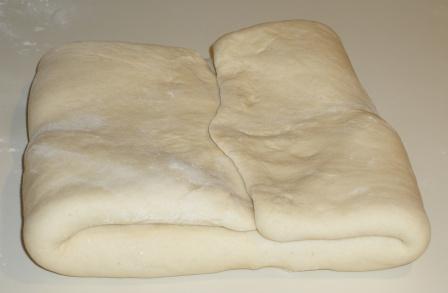
After the three turns that recipe that Katie had found called for, I had a good amount of layers in the dough.
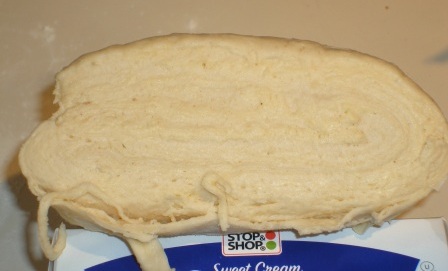
Since I was making both plain croissants and pain au chocolate with some pain au chocolat sticks I purchased during my last order from King Arthur Flour, I divided the dough into half and started about forming my plain croissants. My croissant forming skills need some practice I can tell you!
Regardless, I got both the plain and pain au chocolat formed and set them aside to rise.
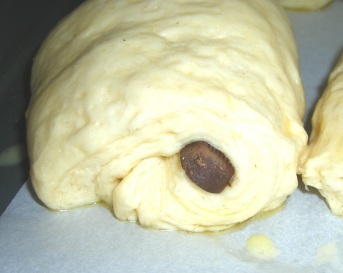
See the melting butter? That is what 84% milk fat butter does when rising in a moderately warm place, it leaks out...
When the croissants came out, I have to say I was quite happy to see all the layers in both the plain croissants
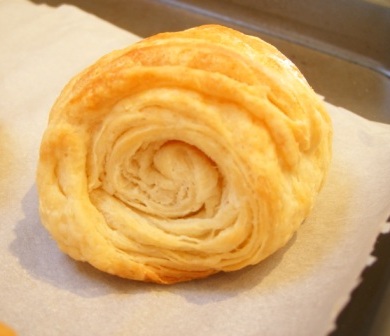
and pain au chocolate.
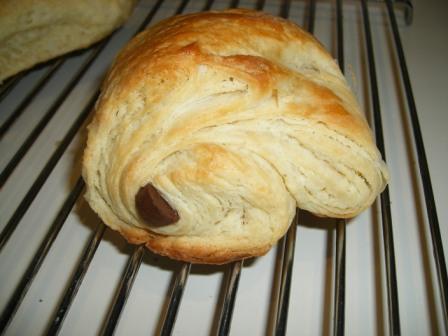
They were flaky and the top layer of the plain ended up on my keyboard when it shattered as I bit into it while typing to Sara on Skype.
While they weren't quite as good as the ones I get when I visit Paris, they were the best croissant I have had this side of the Pond. Of course, my taste testers at the office snarfed them down in about twenty minutes.
Go check out my fellow Babes croissants over there on the sidebar but take a cup of tea or coffee with you!
To be a Bread Baking Buddy this month, you have until February 2, 2009 to make these croissants and post about them. Then email our Host Kitchen, Katie at Thyme for Cooking, with a link to your post and she'll email you a cool Buddy Badge for your blog.
OH and to my really good friend Stephanie, who also made some really great looking croissants this week: I about choked on my morning tea when you started emailing and tweeting me about croissant recipes. It took all my super yeast powers not to tell you what the Babes were making this month!
Adapted Bread Baking Babe Croissant Dough Recipe
from Katie's original BBB Recipe, Tartine
(without preferment), Joy of Cooking: 75th Anniversary Edition
Note: This recipe was made by weights and I used my scale. There is a link in my The Pantry sidebar to a good website for conversion to volume (cups, tsp, etc).
18g active yeast
360ml whole milk, heated to about 90 degrees
500g plain flour
12g fine salt
50g sugar
275g butter, cold but not too hard
12g flour
Egg Wash - 1 egg yolk mixed with 1 Tbsp Water
For the Butter Block:
Combine butter and 12g flour and shape into a square about 10" x 10". Place in fridge overnight or until ready to use.
For Croissant Dough:
Dissolve the yeast in the milk. Put flour, salt and sugar in the bowl of
an electric mixer with dough hook and mix on low. Gradually pour in the
milk/yeast mixture.
Combine until sticky dough ball is formed and dough is pulling away from bowl in stand mixer. Let rest for 20 minutes, cover and place in a warm place and allow to rise until double (about 1 1/2 hours).
Punch down and then allow to rest in fridge overnight or at least 8 hours.
Shape the dough into a ball and cut a 3cm (1 1/4") cross in the center. Roll out the 4 sides to make flaps leaving a center section big enough to hold the butter block. Place butter block in center, and fold the flaps over to completely enclose the butter. Bash the butter into the dough with a rolling pin and roll out to form a large rectangle, 24" X 12".
First Turn: Fold dough in thirds by taking far right third over center third and far left third over top of far right third. Wrap in cling film and refrigerate 30 minutes.
Second Turn: Give the chilled dough a quarter turn, roll out into the rectangle, fold same way as first turn, wrap and refrigerate as above, 30 minutes.
Third Turn: Roll the dough in the opposite direction as before, into the rectangle, fold wrap and refrigerate at least 30 but no more than 60 minutes.
Dough is now ready to use.
To Form Croissants:
Cut a cardboard template, 9cm (3.5") base, 18cm (7") to the point. Lightly flour work surface and roll dough out to 65 X 40cm (26 X 16") rectangle. Lift it slightly off the surface to aerate it to keep it from shrinking. Trim sides with a sharp knife to make straight edges, then cut in half, lengthwise. Using the template as a guide, cut into triangles.
Lay 1 triangle on the work surface. Make a 1cm (1/3") cut in the middle of the base and pull the 2 base points slightly to separate; then pull the top point slightly. Roll the croissant from the base to the point. Place on a baking sheet and turn the base points to form a crescent (You could lay a piece of ham on the base before rolling for a savory croissant) Repeat with the rest of the triangles.
Lightly but thoroughly brush with egg wash.
Put the croissants, on a baking tray, in a warm, preferably slightly humid, place (24 - 30C, 75 - 86F) to rise for 2 hours, or until almost doubled.
Brush with egg wash again, and bake in a preheated 375 degree oven oven for 12 - 14 minutes or until croissant is golden brown.
Serve immediately with butter and jam.
To Make Pain au Chocolat:
40 - 44 sticks of dark chocolate, 4g each
Roll dough into 52 X 46cm (21 X 18") rectangle (It will be a bit thicker than for croissants) Trim rectangle to make straight sides then cut, lengthwise into 4 long strips, about 11cm (4 2/3") wide. Cut across every 7cm (2 3/4") to make small rectangles.
On 1 rectangle, place 1 stick of chocolate on the short end, about 4cm (1 1/2") from the edge. Roll the dough over the chocolate once. Place another stick at the edge of the roll and roll the dough over again. Roll over again. Place on try and brush with egg wash. Let rise, brush again and bake as for croissants.
When done, cool on a wire rack, without touching, before serving. (The chocolate would be very, very hot)
Things I'm going to change for next go around with this recipe:
A. The 84% milk fat butter was a bit over the top and I think contributed to some "runny" butter during the last rise of the formed croissants. I'm going to go with an European butter with less milk fat like 78% to 82%.
B. Less salt. My dough was bit salty
C. More turns. I think 2 more turns would have made the difference in the inner layers of the final product. The inner layers of the croissants and pain au chocolate weren't as flaky as I wanted them to be.







